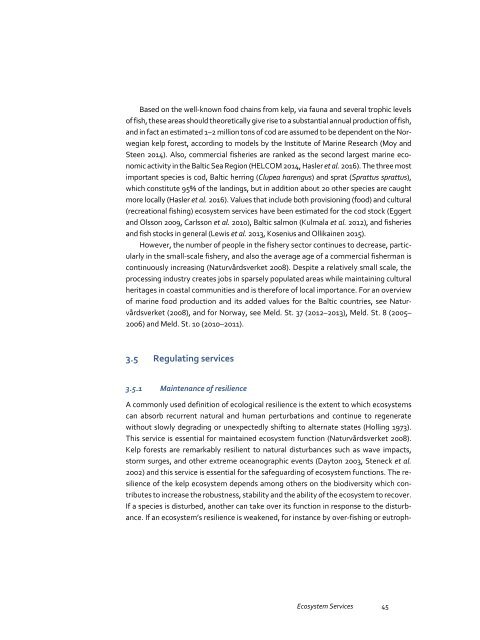Ecosystem Services
FULLTEXT01
FULLTEXT01
Create successful ePaper yourself
Turn your PDF publications into a flip-book with our unique Google optimized e-Paper software.
Based on the well-known food chains from kelp, via fauna and several trophic levels<br />
of fish, these areas should theoretically give rise to a substantial annual production of fish,<br />
and in fact an estimated 1–2 million tons of cod are assumed to be dependent on the Norwegian<br />
kelp forest, according to models by the Institute of Marine Research (Moy and<br />
Steen 2014). Also, commercial fisheries are ranked as the second largest marine economic<br />
activity in the Baltic Sea Region (HELCOM 2014, Hasler et al. 2016). The three most<br />
important species is cod, Baltic herring (Clupea harengus) and sprat (Sprattus sprattus),<br />
which constitute 95% of the landings, but in addition about 20 other species are caught<br />
more locally (Hasler et al. 2016). Values that include both provisioning (food) and cultural<br />
(recreational fishing) ecosystem services have been estimated for the cod stock (Eggert<br />
and Olsson 2009, Carlsson et al. 2010), Baltic salmon (Kulmala et al. 2012), and fisheries<br />
and fish stocks in general (Lewis et al. 2013, Kosenius and Ollikainen 2015).<br />
However, the number of people in the fishery sector continues to decrease, particularly<br />
in the small-scale fishery, and also the average age of a commercial fisherman is<br />
continuously increasing (Naturvårdsverket 2008). Despite a relatively small scale, the<br />
processing industry creates jobs in sparsely populated areas while maintaining cultural<br />
heritages in coastal communities and is therefore of local importance. For an overview<br />
of marine food production and its added values for the Baltic countries, see Naturvårdsverket<br />
(2008), and for Norway, see Meld. St. 37 (2012–2013), Meld. St. 8 (2005–<br />
2006) and Meld. St. 10 (2010–2011).<br />
3.5 Regulating services<br />
3.5.1 Maintenance of resilience<br />
A commonly used definition of ecological resilience is the extent to which ecosystems<br />
can absorb recurrent natural and human perturbations and continue to regenerate<br />
without slowly degrading or unexpectedly shifting to alternate states (Holling 1973).<br />
This service is essential for maintained ecosystem function (Naturvårdsverket 2008).<br />
Kelp forests are remarkably resilient to natural disturbances such as wave impacts,<br />
storm surges, and other extreme oceanographic events (Dayton 2003, Steneck et al.<br />
2002) and this service is essential for the safeguarding of ecosystem functions. The resilience<br />
of the kelp ecosystem depends among others on the biodiversity which contributes<br />
to increase the robustness, stability and the ability of the ecosystem to recover.<br />
If a species is disturbed, another can take over its function in response to the disturbance.<br />
If an ecosystem’s resilience is weakened, for instance by over-fishing or eutroph-<br />
<strong>Ecosystem</strong> <strong>Services</strong> 45


